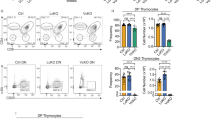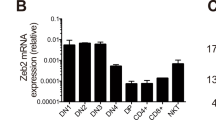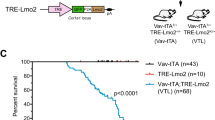Abstract
Brca1 (breast cancer1, early onset) deficiency results in early embryonic lethality. As Brca1 is highly expressed in the T cell lineage, a T cell–specific disruption of Brca1 was generated to assess the role of Brca1 in relation to T lymphocyte development. We found that thymocyte development in Brca1−/− mice was impaired not as a result of V(D)J T cell receptor (TCR) recombination but because thymocytes had increased expression of tumor protein p53. Chromosomal damage accumulation and abnormal cell death were observed in mutant cells. We found that cell death inhibitor Bcl-2 overexpression, or p53−/− backgrounds, completely restored survival and development of Brca1−/− thymocytes; peripheral T cell numbers were not totally restored in Brca1−/− p53−/− mice; and that a mutant background for p21 (cyclin-dependent kinase inhibitor 1A) did not restore Brca1−/− thymocyte development, but partially restored peripheral T cell development. Thus, the outcome of Brca1 deficiency was dependent on cellular context, with the major defects being increased apoptosis in thymocytes, and defective proliferation in peripheral T cells.
This is a preview of subscription content, access via your institution
Access options
Subscribe to this journal
Receive 12 print issues and online access
$209.00 per year
only $17.42 per issue
Buy this article
- Purchase on Springer Link
- Instant access to full article PDF
Prices may be subject to local taxes which are calculated during checkout




Similar content being viewed by others
References
Fischer, A. and Malissen, B. Natural and engineered disorders of lymphocyte development. Science 5361, 237–243 (1998).
Sleckman, B.P. et al. Accessibility control of variable region gene assembly during T-cell development. Immunol. Rev. 165, 121–130 (1998).
Frank, K.M. et al. Late embryonic lethality and impaired V (D)J recombination in mice lacking DNA ligase IV. Nature 396, 173–177 (1998).
Gao, Y. et al. Interplay of p53 and DNA-repair protein XRCC4 in tumorigenesis, genomic stability and development. Nature 404, 897–900 (2000).
Ford, D., Easton, D.F., Bishop, D.T., Narod, S.A. & Goldgar, D.E. Risks of cancer in BRCA1-mutation carriers. Breast Cancer Linkage Consortium. Lancet 343, 692–695 (1994).
Miki, Y. et al. A strong candidate for the breast and ovarian-cancer susceptibility gene. Science 266, 66–71 (1994).
Gudas, J.M. et al. Cell cycle regulation of BRCA1 messenger RNA in human breast epithelial cells. Cell. Growth Differ. 7, 717–723 (1996).
Chen, Y. et al. BRCA1 is a 220-kDa nuclear phosphoprotein that is expressed and phosphorylated in a cell cycle-dependent manner. Cancer Res. 56, 3168–3172 (1996).
Scully, R. et al. Dynamic changes of BRCA1 subnuclear location and phosphorylation state are initiated by DNA damage. Cell 90, 425–435 (1997).
Thomas, J.E., Smith, M., Tonkinson, J.L., Rubinfeld, B. & Polakis, P. Induction of phosphorylation on BRCA1 during the cell cycle and after DNA damage. Cell Growth Differ. 8, 801–809 (1997).
Cortez, D., Wang, Y., Qin, J. & Elledge, S.J. Requirement of ATM-dependent phosphorylation of BRCA1 in the DNA damage response to double-strand breaks. Science 286, 1162–1166 (1999).
Lee, J.S., Collins, K.M., Brown, A.L., Lee, C.H. & Chung, J.H. hCds1-mediated phosphorylation of BRCA1 regulates the DNA damage response. Nature 404, 201–204 (2000).
Scully, R. et al. Association of BRCA1 with Rad51 in mitotic and meiotic cells. Cell 88, 265–275 (1997).
Zhong, Q. et al. Association of BRCA1 with the hRad50-hMre11-p95 complex and the DNA damage response. Science 285, 747–750 (1999).
Shen, S.X. et al. A targeted disruption of the murine Brca1 gene causes gamma-irradiation hypersensitivity and genetic instability. Oncogene 17, 3115–3124 (1998).
Gowen, L.C., Avrutskaya, A.V., Latour, A.M., Koller, B.H. & Leadon, S.A. BRCA1 is required for transcription-coupled repair of oxidative DNA damage. Science 281, 1009–1012 (1998).
Gowen, L.C., Johnson, B.L., Latour, A.M., Sulik, K.K. & Koller, B.H. Brca1 deficiency results in early embryonic lethality characterized by neuroepithelial abnormalities. Nature Genet. 12, 191–194 (1996).
Hakem, R. et al. The tumor suppressor gene Brca1 is required for embryonic cellular proliferation in the mouse. Cell 85, 1009–1023 (1996).
Liu, C.Y., Flesken-Nikitin, A., Li, S., Zeng, Y. & Lee, W.H. Inactivation of the mouse Brca1 gene leads to failure in the morphogenesis of the egg cylinder in early postimplantation development. Genes Dev. 10, 1835–1843 (1996).
Sauer, B. Inducible gene targeting in mice using the Cre/lox system. Methods. Ann. Companion Meth. Enzymol. 14, 381–392 (1998).
Hennet, T., Hagen, F.K., Tabak, L.A. & Marth, J.D. T-cell-specific deletion of a polypeptide N-acetylgalactosaminyl- transferase gene by site-directed recombination. Proc. Natl Acad. Sci. USA 92, 12070–12074 (1995).
Sebzda, E. et al. Selection of the T cell repertoire. Annu. Rev. Immunol. 17, 829–874 (1999).
Levine, A.J. p53, the cellular gatekeeper for growth and division. Cell 88, 323–331 (1997).
el-Deiry, W.S. Regulation of p53 downstream genes. Semin. Cancer Biol. 8, 345–357 (1998).
Oltvai, Z.N., Milliman, C.L. & Korsmeyer, S.J. Bcl2 heterodimerizes in vivo with a conserved homolog Bax, that accelerates programmed cell death. Cell 74, 609–619 (1993).
Ludwig, T., Chapman, D.L., Papaioannou, V.E. & Efstratiadis, A. Targeted mutations of breast cancer susceptibility gene homologs in mice: lethal phenotypes of Brca1, Brca2, Brca1/Brca2, Brca1/p53, and Brca2/p53 nullizygous embryos. Genes Dev. 11, 1226–1241 (1997).
Hakem, R., de la Pompa, J.L., Elia, A., Potter, J. & Mak, T.W. Partial rescue of Brca1 (5-6) early embryonic lethality by p53 or p21 null mutation. Nature Genet. 16, 298–302 (1997).
Linette, G.P. et al. Bcl-2 is upregulated at the CD4+CD8+ stage during positive selection and promotes thymocyte differentiation at several control points. Immunity 1, 197–205 (1994).
Strasser, A., Harris, A.W., Corcoran, L.M. & Cory, S. Bcl-2 expression promotes B- but not T-lymphoid development in scid mice. Nature 368, 457–460 (1994).
Maraskovsky, E. et al. Bcl-2 can rescue T lymphocyte development in interleukin-7 receptor- deficient mice but not in mutant rag-1−/− mice. Cell 89, 1011–1019 (1997).
Haks, M.C., Krimpenfort, P., van den Brakel, J.H. & Kruisbeek, A.M., Pre-TCR signaling and inactivation of p53 induces crucial cell survival pathways in pre-T cells. Immunity 11, 91–101 (1999).
Lengauer, C., Kinzler, K.W. & Vogelstein, B. Genetic instabilities in human cancers. Nature 396, 643–649 (1998).
Difilippantonio, M.J. et al. DNA repair protein Ku80 suppresses chromosomal aberrations and malignant transformation. Nature 404, 510–514 (2000).
Brugarolas, J. et al. Radiation-induced cell cycle arrest compromised by p21 deficiency. Nature 377, 552–557 (1995).
Strasser, A., Harris, A.W. & Cory, S. bcl-2 transgene inhibits T cell death and perturbs thymic self-censorship. Cell 67, 889–899 (1991).
Hakem, R. et al. Differential requirement for caspase 9 in apoptotic patways in vivo. Cell 94, 339–352 (1998).
Dracopoli, N.C. Current Protocols in Human Genetics (John Wiley and Sons Inc, New York, 1999).
Author information
Authors and Affiliations
Corresponding author
Rights and permissions
About this article
Cite this article
Mak, T., Hakem, A., McPherson, J. et al. Brca1 required for T cell lineage development but not TCR loci rearrangement. Nat Immunol 1, 77–82 (2000). https://doi.org/10.1038/76950
Received:
Accepted:
Issue Date:
DOI: https://doi.org/10.1038/76950
This article is cited by
-
BRCA1 and homologous recombination: implications from mouse embryonic development
Cell & Bioscience (2020)
-
BAP31 is involved in T cell activation through TCR signal pathways
Scientific Reports (2017)
-
Mouse models of BRCA1 and their application to breast cancer research
Cancer and Metastasis Reviews (2013)
-
IL-7Rα deficiency in p53null mice exacerbates thymocyte telomere erosion and lymphomagenesis
Cell Death & Differentiation (2012)
-
Loss of poly(ADP-ribose) polymerase-2 leads to rapid development of spontaneous T-cell lymphomas in p53-deficient mice
Oncogene (2010)



